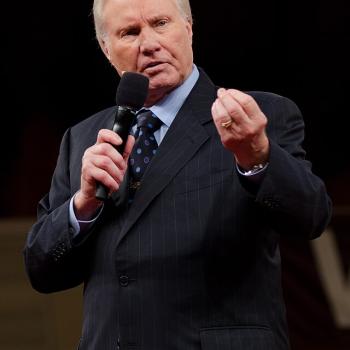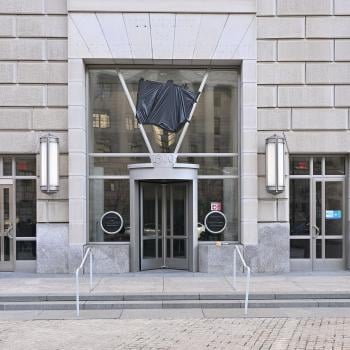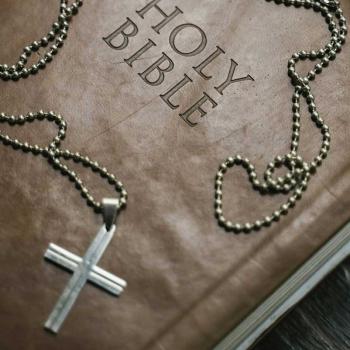Announcing My Newest Book: Counterfeit Christianity: The Persistence of Errors in the Church
A couple years ago I was approached by a requisitions editor at Abingdon Press (the United Methodist Publishing House) to write a book about heresies. I never knew the publisher’s exact motive, but I suspect it is part of a general concern among many (including some bishops I know) in the United Methodist Church to turn around the denomination’s “theological pluralism” and renew at least a general sense of Christian orthodoxy within the UMC. (That is not to say that has been totally lacking; it is only to say that very many UMC people have come to believe doctrine simply does not matter and they are free to believe whatever they want to believe.)
I agreed to the request and the product is now published—Counterfeit Christianity: The Persistence of Errors in the Church (2015). Amazon has it becoming available August 4, but I have received a box of author’s copies, so I assume it is now available for pre-order if not actual purchase. If I am not mistaken this is my eighteenth book (including co-authored books but not multi-authored books of which I have contributed to too many to keep count.)
Before the describing the book in some detail, I must reluctantly say that I am not happy with the title or the cover—over which I had no “say.” Most people do not realize that publishers assign book titles and cover designs. Sometimes authors have a say, but often they do not. I tried gently to object to “Counterfeit Christianity” to no avail. And by the time I saw the cover it was too late to object. My preferred title was “Heresies Ancient and Modern: The Persistence of Errors in the Churches.” Marketers have the most say about book titles; they are concerned with what will sell books. The reason I don’t like “Counterfeit Christianity” is that I do not think heresy necessarily equates with “counterfeit Christianity.” It depends. Some heresies labeled “Christian” do that; others do not. And I especially do not want people to think that just because I disagree with someone and even think their ideas about God, Jesus Christ, salvation, etc., are seriously mistaken I want to label them false Christians.
The book can be purchased together with a DVD containing an edited portion of a very lengthy conversation about the book between Adam Hamilton and me. Adam is, of course, the pastor of the largest UMC church in North America—The Church of the Resurrection in suburban Kansas City (Kansas). Adam is a former student of mine and I am very proud of him. At the publisher’s request he took almost an entire day out of his extremely busy schedule (he leads a church with 23,000 members!) to sit with me and film a conversation about theology. We talked, with cameras rolling, for about five hours. I think the DVD contains five segments of about eight to ten minutes each—mainly for use in small groups in churches. But, of course, anyone can purchase it. (I won’t be watching it as I literally cannot stand to watch myself or listen to myself! And I would constantly be thinking of what Adam and I said that was cut out in the editing process.)
(There’s an interesting—to me, at least—back story to my meeting with Adam at his church in Leawood, Kansas. It happened in early May, but was planned for months. The publisher and church made many arrangements including a camera and sound crew. A lead Abingdon editor flew in from Nashville to direct and produce the interview. The day before the event weather predictions for my airport were dire—severe thunderstorms and possible tornadoes! And I have slept on the floor of that airport before when my flights were cancelled due to such weather events. (It’s 100 miles from my home!) So, rather than risk missing the event, I jumped in my car and drove ten hours to Kansas City, Kansas. Then drove back after the interview the next day. I passed the hours in the car by listening to old gospel songs I downloaded from itunes to my ipod and singing along with them. I thank God for itunes and ipods! I have over 100 old gospel songs from the 1950s and 1960s—before CCM took over—on my ipod. Sorry for that digression.)
It was so good to see and be with Adam again after thirty-four years. We discovered that he was in my very first theology class when I began teaching full time. I was still writing my dissertation and had just returned from a year studying with Wolfhart Pannenberg in Germany. Adam is, of course, an author in his own right and a theologian-pastor—a model for others to follow. His most recent book is Making Sense of the Bible: Rediscovering the Power of Scripture Today (HarperOne, 2014). He gave me a copy with this personal note written inside: “Dear Roger, I am so grateful for you. You were my first professor of theology. Thank you for helping me to make sense of the Bible! Blessings! Adam Hamilton.” Few things make an old theologian happier than something like that!
Back to Counterfeit Christianity. I wrote the book in a fairly popular style, assuming no knowledge of theology or church history on the parts of readers. The back of the book contains this description: “Historic heresies didn’t die or fade away. Each generation boasts its own. Modern-day versions continue to plague churches and undermine the good news of Jesus. In this book Roger Olson describes not only the curses that heresies bring the church but also the gifts. Heresies can occasionally correct a version of orthodoxy, but ultimately they are not simple confusions or misunderstandings. Instead they are dangerous distortions that undermine the faith. This book describes major heresies, how the church dealt with them, the players involved, and what pastors can do to address these faith issues in order to educate congregations about Jesus, God, and salvation.” The back cover includes endorsements by Adam Hamilton, Henry H. Knight, III (theology professor at Methodist-related St. Paul School of Theology), and Don Thorsen (theology professor at Azusa Pacific Seminary).
The table of contents includes “Understanding Heresy,” “Understanding Orthodoxy,” “The Mother of All Heresies: Gnosticism,” “Messing with Divine Revelation: Montanism and Marcionism,” “Doubting the Deity of Jesus Christ: Adoptionism, Arianism, and Nestorianism,” “Contesting the Trinity: Subordinationism, Modalism, and Tritheism,” “Setting Grace Aside: Pelagianism and Semi-Pelagianism,” “Making God a Monster: Divine Determinism,” “Reducing God to Manageable Size: Moralistic Therapeutic Deism,” and “Using God for Personal Gain: The ‘Gospel’ of Health and Wealth.” The first several chapters describe the heresies as they arose and existed in ancient Christianity and their contemporary forms.
One of my main points in the first chapter is that a person is not a “heretic” merely for holding mistaken beliefs, even those declared heresies by the church ecumenical and orthodox. A “heretic” is only someone who knowingly teaches what his or her faith community considers heretical. There is no such thing as an “accidental heretic.” A person is only a “heretic” when he or she realizes that what he or she teaches is heretical—according to his or her church or the Great Tradition of ecumenical Christian orthodoxy agreed to by Eastern Orthodox, Catholic and Protestant churches.
Nevertheless, there are heresies “swimming around” in contemporary Christianity. The people who believe them are not necessarily bad people and, in most cases, are sincere Christians who are simply confused and need correction. The problem is almost nobody is correcting them! Especially Protestant churches in America have relegated “orthodoxy” to fundamentalism. The result is doctrinal chaos, an “uncertain sound,” syncretized “Christianity,” and a kind of folk religion in which anything goes and everyone’s opinion is as good as anyone else’s.
I urge you to buy the book and read it and even adopt it for your church’s discussion group—in spite of the infelicitous title and (in my opinion) silly cover.












